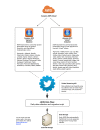Establishing a Link Between Prescription Drug Abuse and Illicit Online Pharmacies: Analysis of Twitter Data
- PMID: 26677966
- PMCID: PMC4704982
- DOI: 10.2196/jmir.5144
Establishing a Link Between Prescription Drug Abuse and Illicit Online Pharmacies: Analysis of Twitter Data
Abstract
Background: Youth and adolescent non-medical use of prescription medications (NUPM) has become a national epidemic. However, little is known about the association between promotion of NUPM behavior and access via the popular social media microblogging site, Twitter, which is currently used by a third of all teens.
Objective: In order to better assess NUPM behavior online, this study conducts surveillance and analysis of Twitter data to characterize the frequency of NUPM-related tweets and also identifies illegal access to drugs of abuse via online pharmacies.
Methods: Tweets were collected over a 2-week period from April 1-14, 2015, by applying NUPM keyword filters for both generic/chemical and street names associated with drugs of abuse using the Twitter public streaming application programming interface. Tweets were then analyzed for relevance to NUPM and whether they promoted illegal online access to prescription drugs using a protocol of content coding and supervised machine learning.
Results: A total of 2,417,662 tweets were collected and analyzed for this study. Tweets filtered for generic drugs names comprised 232,108 tweets, including 22,174 unique associated uniform resource locators (URLs), and 2,185,554 tweets (376,304 unique URLs) filtered for street names. Applying an iterative process of manual content coding and supervised machine learning, 81.72% of the generic and 12.28% of the street NUPM datasets were predicted as having content relevant to NUPM respectively. By examining hyperlinks associated with NUPM relevant content for the generic Twitter dataset, we discovered that 75.72% of the tweets with URLs included a hyperlink to an online marketing affiliate that directly linked to an illicit online pharmacy advertising the sale of Valium without a prescription.
Conclusions: This study examined the association between Twitter content, NUPM behavior promotion, and online access to drugs using a broad set of prescription drug keywords. Initial results are concerning, as our study found over 45,000 tweets that directly promoted NUPM by providing a URL that actively marketed the illegal online sale of prescription drugs of abuse. Additional research is needed to further establish the link between Twitter content and NUPM, as well as to help inform future technology-based tools, online health promotion activities, and public policy to combat NUPM online.
Keywords: cyberpharmacies; eHealth; illicit Internet pharmacies; infodemiology; infoveillance; prescription drug abuse; social media; surveillance; twitter.
Conflict of interest statement
Conflicts of Interest: TM is a non-compensated member of the ASOP academic advisory panel of ASOP, and both TK and TM received funding for this project from ASOP through a pilot research grant exploring prescription drug abuse risks online.
Figures
Similar articles
-
Solution to Detect, Classify, and Report Illicit Online Marketing and Sales of Controlled Substances via Twitter: Using Machine Learning and Web Forensics to Combat Digital Opioid Access.J Med Internet Res. 2018 Apr 27;20(4):e10029. doi: 10.2196/10029. J Med Internet Res. 2018. PMID: 29613851 Free PMC article.
-
Twitter-Based Detection of Illegal Online Sale of Prescription Opioid.Am J Public Health. 2017 Dec;107(12):1910-1915. doi: 10.2105/AJPH.2017.303994. Epub 2017 Oct 19. Am J Public Health. 2017. PMID: 29048960 Free PMC article.
-
Exploring trends of nonmedical use of prescription drugs and polydrug abuse in the Twittersphere using unsupervised machine learning.Addict Behav. 2017 Feb;65:289-295. doi: 10.1016/j.addbeh.2016.08.019. Epub 2016 Aug 17. Addict Behav. 2017. PMID: 27568339
-
Digital danger: a review of the global public health, patient safety and cybersecurity threats posed by illicit online pharmacies.Br Med Bull. 2016 Jun;118(1):110-26. doi: 10.1093/bmb/ldw016. Epub 2016 May 5. Br Med Bull. 2016. PMID: 27151957 Free PMC article. Review.
-
Toward a Mixed-Methods Research Approach to Content Analysis in The Digital Age: The Combined Content-Analysis Model and its Applications to Health Care Twitter Feeds.J Med Internet Res. 2016 Mar 8;18(3):e60. doi: 10.2196/jmir.5391. J Med Internet Res. 2016. PMID: 26957477 Free PMC article. Review.
Cited by
-
The Impact of Government Social Media Information Quality on Public Panic During the Infodemic.Front Psychol. 2022 May 13;13:908213. doi: 10.3389/fpsyg.2022.908213. eCollection 2022. Front Psychol. 2022. PMID: 35645859 Free PMC article.
-
Illicit Trade of Prescription Medications Through X (Formerly Twitter) in Japan: Cross-Sectional Study.JMIR Form Res. 2024 May 28;8:e54023. doi: 10.2196/54023. JMIR Form Res. 2024. PMID: 38805262 Free PMC article.
-
Barriers to opioid use disorder treatment: A comparison of self-reported information from social media with barriers found in literature.Front Public Health. 2023 Apr 20;11:1141093. doi: 10.3389/fpubh.2023.1141093. eCollection 2023. Front Public Health. 2023. PMID: 37151596 Free PMC article.
-
The potential use of social media and other internet-related data and communications for child maltreatment surveillance and epidemiological research: Scoping review and recommendations.Child Abuse Negl. 2018 Nov;85:187-201. doi: 10.1016/j.chiabu.2018.01.014. Epub 2018 Feb 1. Child Abuse Negl. 2018. PMID: 29366596 Free PMC article.
-
Exploring Perceptions About Paracetamol, Tramadol, and Codeine on Twitter Using Machine Learning: Quantitative and Qualitative Observational Study.J Med Internet Res. 2023 Nov 14;25:e45660. doi: 10.2196/45660. J Med Internet Res. 2023. PMID: 37962927 Free PMC article.
References
-
- Mackey TK, Liang BA, Strathdee SA. Digital social media, youth, and nonmedical use of prescription drugs: the need for reform. J Med Internet Res. 2013;15(7):e143. doi: 10.2196/jmir.2464. http://www.jmir.org/2013/7/e143/ v15i7e143 - DOI - PMC - PubMed
-
- McCabe SE, West BT, Teter CJ, Boyd CJ. Co-ingestion of prescription opioids and other drugs among high school seniors: results from a national study. Drug Alcohol Depend. 2012 Nov 1;126(1-2):65–70. doi: 10.1016/j.drugalcdep.2012.04.017. http://europepmc.org/abstract/MED/22609061 S0376-8716(12)00143-3 - DOI - PMC - PubMed
-
- Inciardi JA, Surratt HL, Cicero TJ, Rosenblum A, Ahwah C, Bailey JE, Dart RC, Burke JJ. Prescription drugs purchased through the internet: who are the end users? Drug Alcohol Depend. 2010 Jul 1;110(1-2):21–29. doi: 10.1016/j.drugalcdep.2010.01.015. http://europepmc.org/abstract/MED/20227199 S0376-8716(10)00055-4 - DOI - PMC - PubMed
-
- Lenhard A. Pew Internet Research. 2015. Apr 09, [2015-11-30]. Teens, Social Media & Technology Overview 2015 http://www.pewinternet.org/2015/04/09/teens-social-media-technology-2015/
Publication types
MeSH terms
Substances
LinkOut - more resources
Full Text Sources
Other Literature Sources
Medical
Miscellaneous






